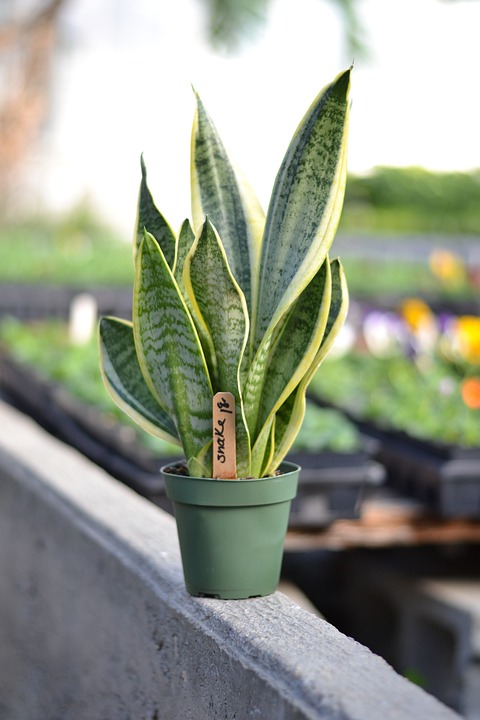Read the Graptopetalum Paraguayense Growing and Care Guide for expert tips on cultivating this stunning succulent.
Explore the Graptopetalum Paraguayense Growing and Care Guide to include this beautiful plant in your home and garden.
Common Names: Mother of Pearl, Ghost Plant
Botanical Name: Graptopetalum Paraguayense
USDA Zones: 9-11; zones 7-8 with winter protection
Learn Dischidia Nummularia Care
What is Graptopetalum Paraguayense?
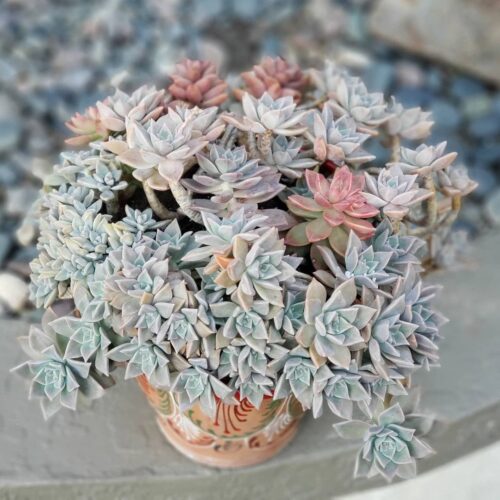
Graptopetalum paraguayense, commonly known as Ghost Plant, belongs to the family Crassulaceae. It is native to Tamaulipas, Mexico. Ghost Plants have a rosette-like appearance with thick, fleshy leaves that are pale blue-green in color. The leaves are shaped like flattened teardrops and have a powdery, chalky coating.
Ghost Plants are generally slow-growing succulents that can reach a height of around 6 to 12 inches and have a spread of about 2-3 feet. They tend to form small clumps over time.
The flowers of Graptopetalum paraguayense are small and star-shaped, typically in shades of white, pink, or yellow. They appear on tall stems above the foliage during the spring and summer months.
These succulents are drought-tolerant and prefer well-draining soil. They thrive in full sun to partial shade and are suitable for outdoor gardens and containers. Ghost Plants are easy to care for and are a popular choice among succulent enthusiasts and beginners due to their low maintenance requirements.
Read about Graptosedum ‘Daruma Shu-rei’ Care
How to Propagate Graptopetalum paraguayense Plant
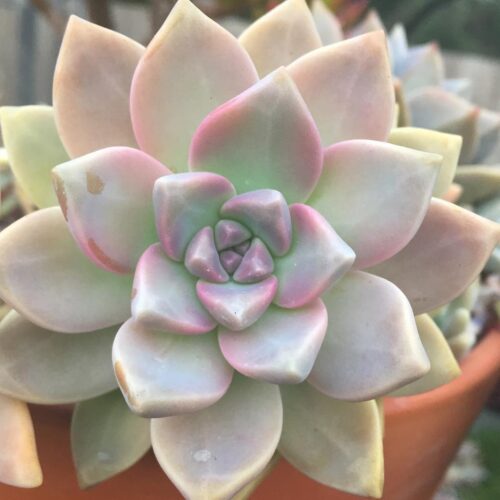
Propagate Graptopetalum paraguayense (Ghost Plant) from leaf
- Choose a healthy leaf from the Graptopetalum paraguayense plant. Look for a leaf that is plump and free from disease or damage.
- Gently twist or cut the leaf from the plant, ensuring you get a clean break.
- Place the cut end of the leaf in a dry, shaded spot for a few days to allow it to callus. This step is crucial to prevent rot when planting the cutting.
- Fill a small container with drainage holes or a tray with well-draining succulent potting mix.
- After the leaf has calloused, plant it about 1-2 inches deep into the potting mix.
- You can insert the cut end directly into the soil without applying the rooting hormone.
- Place the container in a location with bright, indirect sunlight. Avoid direct sunlight, as it can scorch the cutting.
- Water sparingly, allowing the soil to dry out between waterings. Overwatering can lead to rot, so be cautious.
- Over several weeks to a couple of months, the leaf-cutting will start to develop roots.
- You can gently tug it to check for resistance, indicating root growth. Keep the soil consistently lightly moist but not soggy during this period.
- Once the cutting has developed a sufficient root system (usually when it has grown a few inches tall), you can transplant it into a larger pot or directly into your garden if desired.
- Continue to care for your newly propagated Graptopetalum paraguayense as you would for a mature plant, providing well-draining soil, bright indirect sunlight, and sparing watering.
Pot Size for Growing Graptopetalum paraguayense
For Graptopetalum paraguayense, an ideal pot size is around 4-6 inches in diameter. Choose a terra cotta or ceramic pot with drainage holes to ensure proper moisture control. The pot should be small enough to promote root development but large enough to accommodate the plant’s growth.
Discover Elephant Bush vs. Jade Plant
Graptopetalum paraguayense Varieties
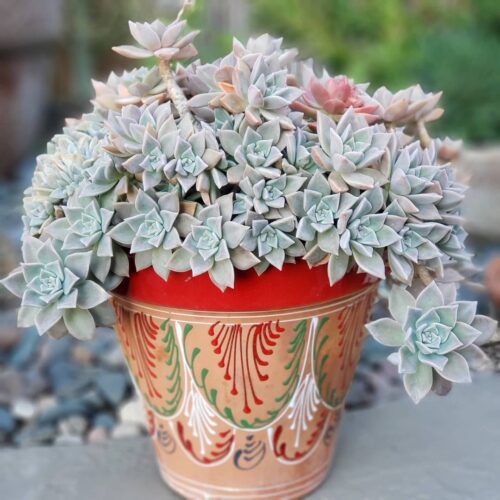
- “Fred Ives” Graptopetalum paraguayense: A cultivar with striking red and pink hues on its leaves.
- “Ghost Plant” Graptopetalum paraguayense: The classic variety with silvery-gray leaves that look ghostly.
- “Superbum” Graptopetalum paraguayense: Distinct for its larger, thicker leaves and a more pronounced rosette shape
- “Mother of Pearl” Graptopetalum paraguayense: It displays sparkling foliage that looks like the shiny interior of a seashell.
Find Is Agave a Cactus or Not?
Ideal Growing Conditions for Graptopetalum Paraguayense
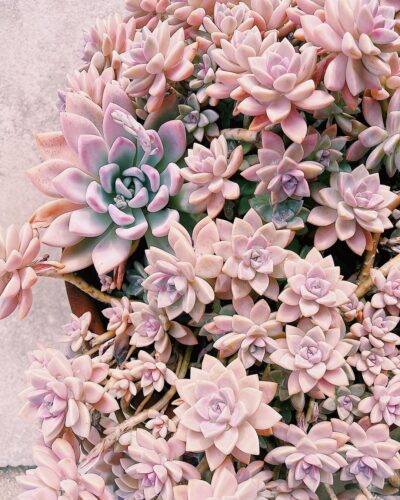
Location
The ideal light for Ghost Plant is bright, indirect sunlight. It thrives when placed in a location that receives gentle morning or dappled sunlight throughout the day. Avoid direct, intense sunlight to prevent leaf damage and ensure the plant’s health and vibrant appearance.
Soil
Graptopetalum Paraguayense thrives in well-draining succulent soil. You can create this by mixing potting soil with perlite or coarse sand in a 2:1 ratio. The ideal pH level is slightly acidic to neutral, around 6.0 to 7.0. Good drainage is crucial to prevent root rot and ensure healthy growth.
Water
Ghost Plant requires allowing the soil to dry between watering. Typically, water is every 2-3 weeks in the growing season (spring and summer) and reduced to once a month in winter. Water at the base of the plant, avoiding the leaves, to prevent rot. Adjust the frequency based on environmental conditions and plant needs.
Temperature and Humidity
Graptopetalum Paraguayense, or Ghost Plant, thrives in temperatures between 65°F to 80°F (18°C to 27°C). It prefers low to moderate humidity levels, around 40-50%. Protect it from frost and extreme heat, as it’s sensitive to extreme temperatures. Keep it in a comfortable, well-ventilated environment to promote healthy growth.
READ Tips to Grow Dischidia Geri in the Pots
Graptopetalum paraguayense Care
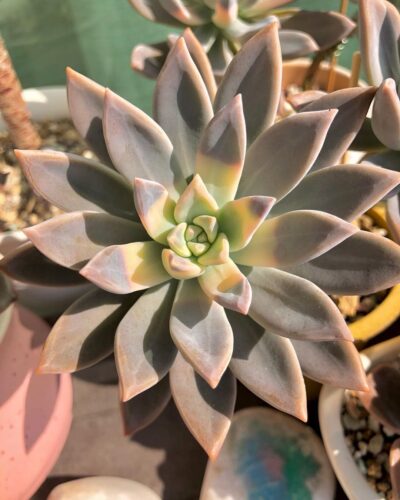
Fertilizer
Graptopetalum paraguayense has relatively low fertilizing needs. Consider using nutrient-rich approaches like manure tea or compost as a side-dressing to maintain the vigor of your Ghost Plants. Sometimes, a mild yearly feeding with diluted cactus fertilizer may be suitable.
Repotting
To repot Graptopetalum paraguayense, choose a slightly larger pot with good drainage. Gently remove the plant from its old pot, shake off excess soil, and inspect the roots. Place it in the new pot with well-draining succulent soil. Allow it to settle for a few days before watering. Repot every 2-3 years to accommodate growth.
Pruning
Pruning Ghost Plant helps maintain its shape and remove dead or leggy growth. Use clean, sharp scissors or pruning shears to trim damaged or overgrown stems during the active growing season, typically in spring or early summer. Avoid cutting into the woody base and allow cuttings to callus before replanting.
Overwintering
In regions with mild winters, Graptopetalum paraguayense requires no special overwintering care. However, in colder zones, protect outdoor plants by mulching during the coldest months, removing them when temperatures rise above freezing.
For indoor plants or those brought indoors for winter, place them in bright, sunny windows with temperatures between 65 to 75°F (18-24°C). Avoid proximity to heaters. During winter, reduce watering slightly as the plant naturally enters a dormant phase.
Pests and Diseases
Pests:
- Mealybugs: These tiny, white, cottony pests are a common problem for many succulents, including Ghost Plants. They feed on the plant’s sap, causing leaves to turn yellow and distorted. To get rid of mealybugs, use a soft brush or cotton swab dipped in alcohol to gently remove them from the plant. You can also use insecticidal soap or neem oil to control infestations.
- Aphids: They are small, soft-bodied insects that can cluster on the new growth of Graptopetalum paraguayense.Aphids feed on the plant’s sap and can cause leaves to become distorted and sticky with honeydew. Use a gentle spray of water or insecticidal soap to dislodge and remove aphids from the plant.
- Spider Mites: These tiny pests are more common in dry and dusty conditions. They create fine webs on the plant and suck the sap, leading to yellowing and mottled leaves. Rinse the plant with a strong stream of water or use insecticidal soap to control spider mites.
Diseases:
- Root Rot: This is one of the most common diseases affecting Graptopetalum paraguayense and many other succulents. It occurs when the roots are consistently exposed to excess moisture, leading to fungal infection. To prevent root rot, ensure well-draining soil and pots with drainage holes. Water sparingly, and allow the soil to dry between waterings.
- Powdery Mildew: Powdery mildew appears as a white, powdery substance on the leaves. It’s a fungal disease that thrives in humid conditions. Improve air circulation around the plant, avoid overcrowding, and remove affected leaves. Fungicides can also be used for severe cases.
- Black Spot: Black spots on the leaves can be a sign of fungal infection. Remove affected leaves promptly, and ensure the plant isn’t subjected to excessive humidity.
READ Dischidia hirsuta ‘Red Leaf’ Growing Tips
Toxicity
Graptopetalum paraguayense, or Ghost Plant, is generally considered non-toxic to humans and most pets, including cats and dogs. This succulent does not contain any known harmful chemicals or compounds that pose a significant threat when ingested or touched.
However, while it is considered safe, it’s always a good practice to prevent pets and small children from consuming any plant material, as individual sensitivities can vary, and some succulents may cause mild gastrointestinal discomfort if ingested in large quantities.
READ Tips to Grow String of Pearls From Cuttings
How to Get Ghost Plant to Bloom
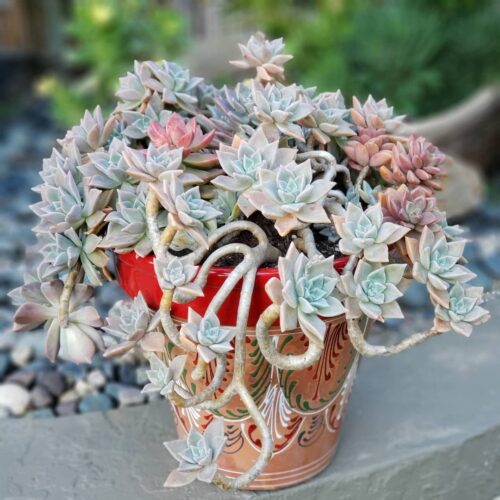
Encouraging a Ghost Plant (Graptopetalum paraguayense) to bloom involves providing optimal conditions. Ensure it receives bright, indirect sunlight, well-draining soil, and careful watering. Maintain temperatures between 60-80°F (15-27°C), fertilize during the growing season, and prune as needed. Mimic a winter rest period to stimulate blooming and watch for pests. Patience is key as these succulents may take years to mature and flower. When you notice tiny bud formations, your Ghost Plant is on its way to producing its beautiful star-shaped blooms.
Learn Dancing Bones Cactus Care



